change wheel PORSCHE 911 TURBO 2014 6.G User Guide
[x] Cancel search | Manufacturer: PORSCHE, Model Year: 2014, Model line: 911 TURBO, Model: PORSCHE 911 TURBO 2014 6.GPages: 300, PDF Size: 10.61 MB
Page 115 of 300
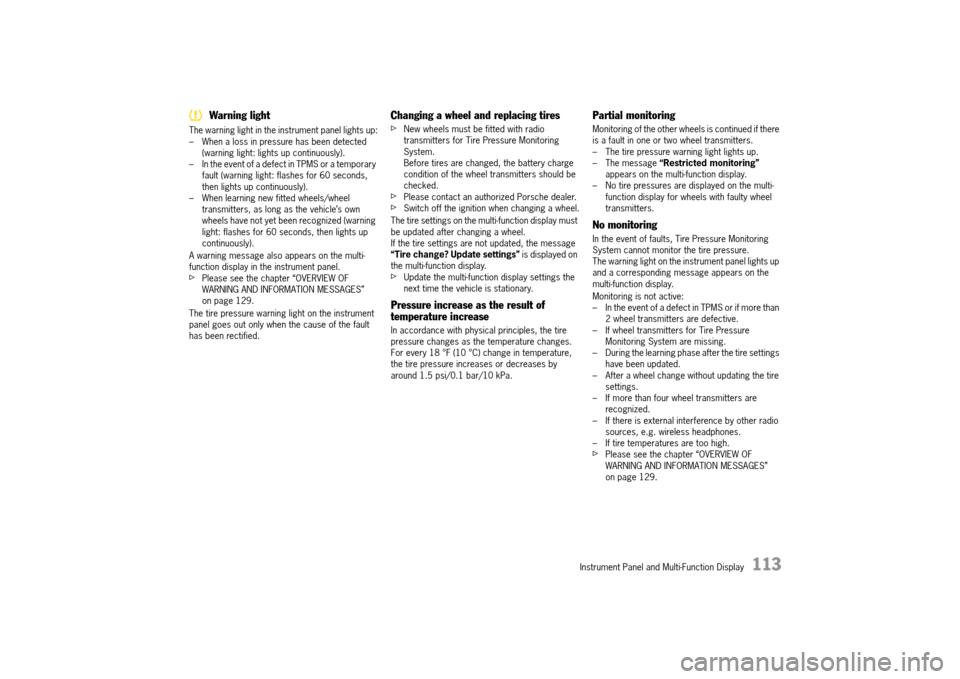
Instrument Panel and Multi-Function Display 113
Warning light
The warning light in the instrument panel lights up: – When a loss in pressure has been detected (warning light: lights up continuously).– In the event of a defect in TPMS or a temporary fault (warning light: flashes for 60 seconds, then lights up continuously).– When learning new fitted wheels/wheel transmitters, as long as the vehicle’s own wheels have not yet been recognized (warning light: flashes for 60 seconds, then lights up continuously).
A warning message also appears on the multi- function display in the instrument panel.fPlease see the chapter “OVERVIEW OF WARNING AND INFORMATION MESSAGES” on page 129.
The tire pressure warning light on the instrument panel goes out only when the cause of the fault has been rectified.
Changing a wheel and replacing tires
fNew wheels must be fitted with radio transmitters for Tire Pressure Monitoring System. Before tires are changed, the battery charge condition of the wheel transmitters should be checked.fPlease contact an authorized Porsche dealer.fSwitch off the ignition when changing a wheel.
The tire settings on the multi-function display must be updated after changing a wheel.If the tire settings are not updated, the message “Tire change? Update settings” is displayed on the multi-function display.fUpdate the multi-function display settings the next time the vehicle is stationary.
Pressure increase as the result of temperature increase
In accordance with physical principles, the tire pressure changes as the temperature changes.For every 18 °F (10 °C) change in temperature, the tire pressure increases or decreases by around 1.5 psi/0.1 bar/10 kPa.
Partial monitoring
Monitoring of the other wheels is continued if there is a fault in one or two wheel transmitters.– The tire pressure warning light lights up.– The message “Restricted monitoring” appears on the multi-function display.– No tire pressures are displayed on the multi-function display for wheels with faulty wheel transmitters.
No monitoring
In the event of faults, Tire Pressure Monitoring System cannot monitor the tire pressure. The warning light on the instrument panel lights up and a corresponding message appears on the multi-function display.
Monitoring is not active: – In the event of a defect in TPMS or if more than 2 wheel transmitters are defective.– If wheel transmitters for Tire Pressure Monitoring System are missing.– During the learning phase after the tire settings have been updated.– After a wheel change without updating the tire settings.– If more than four wheel transmitters are recognized.– If there is external interference by other radio sources, e.g. wireless headphones.– If tire temperatures are too high.fPlease see the chapter “OVERVIEW OF WARNING AND INFORMATION MESSAGES” on page 129.
14_991_Turbo_21.book Seite 113 Mittwoch, 9. April 2014 2:19 14
Page 129 of 300
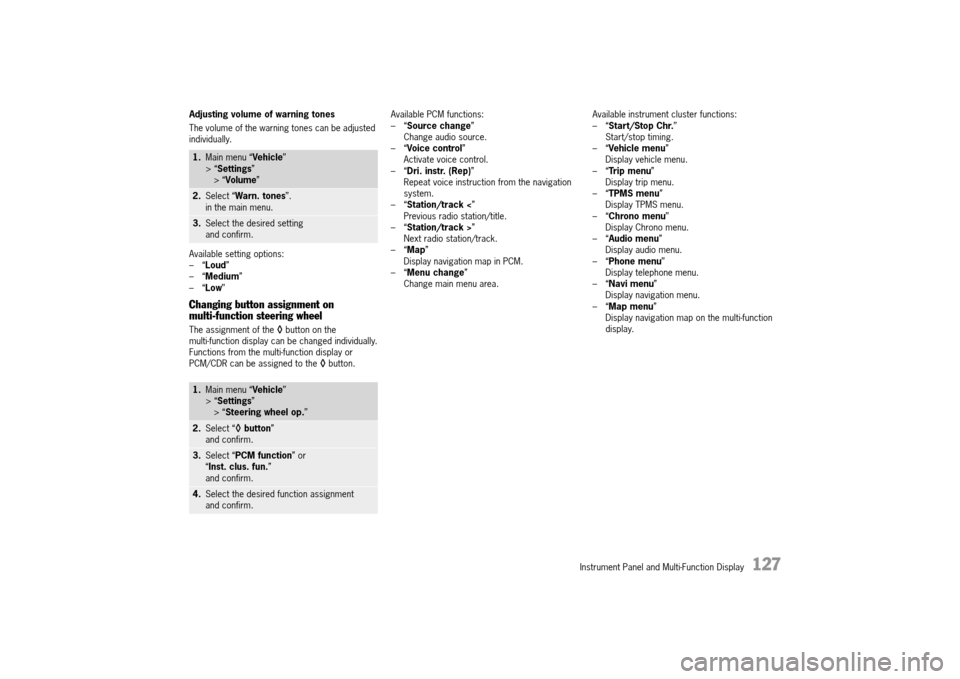
Instrument Panel and Multi-Function Display 127
Adjusting volume of warning tones
The volume of the warning tones can be adjusted individually.
Available setting options: –“ Loud” –“ Medium” –“ Low”
Changing button assignment on multi-function steering wheel
The assignment of the ◊ button on the multi-function display can be changed individually.Functions from the multi-function display or PCM/CDR can be assigned to the ◊ button.
Available PCM functions: –“ Source change” Change audio source.–“ Voice control” Activate voice control.–“ Dri. instr. (Rep)” Repeat voice instruction from the navigation system.–“ Station/track <” Previous radio station/title.–“ Station/track >” Next radio station/track.–“ Map” Display navigation map in PCM.–“ Menu change” Change main menu area.
Available instrument cluster functions: –“ Start/Stop Chr.” Start/stop timing.–“ Vehicle menu” Display vehicle menu.–“ Trip menu” Display trip menu.–“ TPMS menu” Display TPMS menu.–“ Chrono menu” Display Chrono menu.–“ Audio menu” Display audio menu.–“ Phone menu” Display telephone menu.–“ Navi menu” Display navigation menu.–“ Map menu” Display navigation map on the multi-function display.
1. Main menu “Vehicle” > “ Settings” > “ Volume”
2.Select “Warn. tones”. in the main menu.
3. Select the desired setting and confirm.
1. Main menu “Vehicle” > “ Settings” > “ Steering wheel op.”
2.Select “◊ button” and confirm.
3. Select “PCM function” or “ Inst. clus. fun.” and confirm.
4. Select the desired function assignment and confirm.
14_991_Turbo_21.book Seite 127 Mittwoch, 9. April 2014 2:19 14
Page 137 of 300
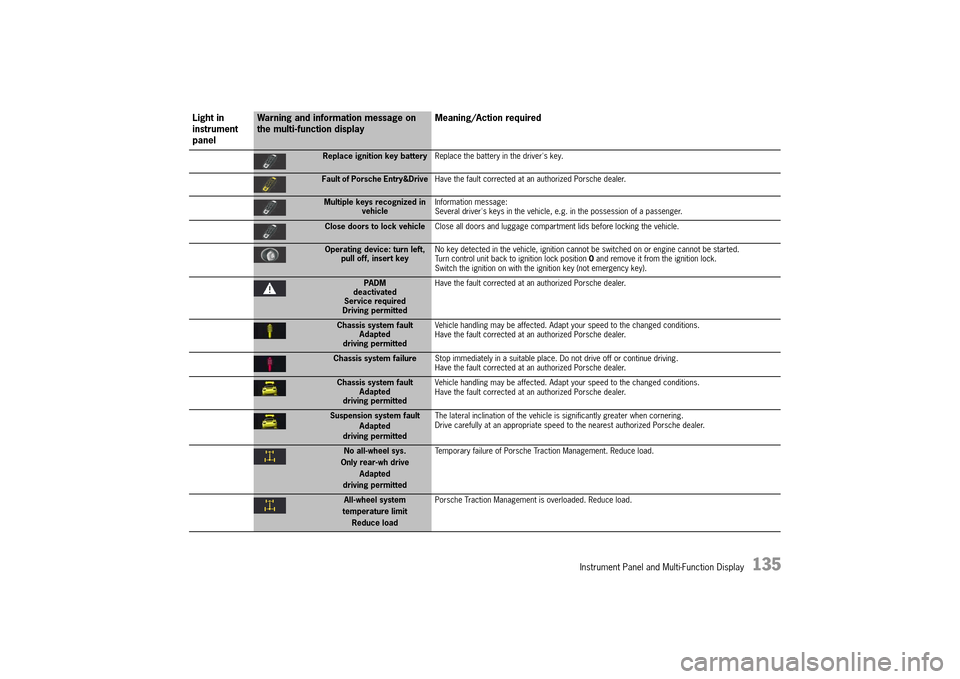
Instrument Panel and Multi-Function Display 135
Replace ignition key batteryReplace the battery in the driver's key.
Fault of Porsche Entry&DriveHave the fault corrected at an authorized Porsche dealer.
Multiple keys recognized in vehicle Information message: Several driver's keys in the vehicle, e.g. in the possession of a passenger.
Close doors to lock vehicle Close all doors and luggage compartment lids before locking the vehicle.
Operating device: turn left, pull off, insert key No key detected in the vehicle, ignition cannot be switched on or engine cannot be started. Turn control unit back to ignition lock position 0 and remove it from the ignition lock. Switch the ignition on with the ignition key (not emergency key).
PADM deactivatedService requiredDriving permitted
Have the fault corrected at an authorized Porsche dealer.
Chassis system fault Adapteddriving permitted
Vehicle handling may be affected. Adapt your speed to the changed conditions. Have the fault corrected at an authorized Porsche dealer.
Chassis system failure Stop immediately in a suitable place. Do not drive off or continue driving. Have the fault corrected at an authorized Porsche dealer.
Chassis system fault Adapteddriving permitted
Vehicle handling may be affected. Adapt your speed to the changed conditions. Have the fault corrected at an authorized Porsche dealer.
Suspension system fault Adapteddriving permitted
The lateral inclination of the vehicle is significantly greater when cornering. Drive carefully at an appropriate speed to the nearest authorized Porsche dealer.
No all-wheel sys. Only rear-wh driveAdapted
driving permitted
Temporary failure of Porsche Traction Management. Reduce load.
All-wheel system temperature limitReduce load
Porsche Traction Management is overloaded. Reduce load.
Light in instrument panel
Warning and information message on the multi-function display Meaning/Action required
14_991_Turbo_21.book Seite 135 Mittwoch, 9. April 2014 2:19 14
Page 139 of 300
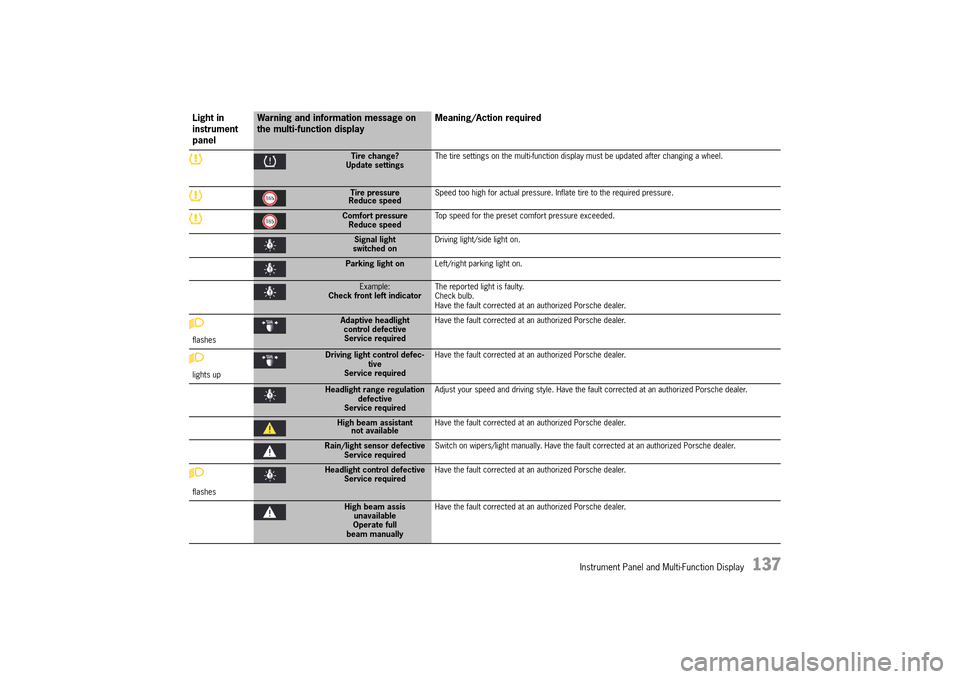
Instrument Panel and Multi-Function Display 137
Tire change? Update settings The tire settings on the multi-function display must be updated after changing a wheel.
Tire pressure Reduce speed Speed too high for actual pressure. Inflate tire to the required pressure.
Comfort pressure Reduce speed Top speed for the preset comfort pressure exceeded.
Signal light switched on Driving light/side light on.
Parking light on Left/right parking light on.
Example: Check front left indicator The reported light is faulty. Check bulb.Have the fault corrected at an authorized Porsche dealer.
flashes
Adaptive headlight control defectiveService required
Have the fault corrected at an authorized Porsche dealer.
lights up
Driving light control defec- tiveService required
Have the fault corrected at an authorized Porsche dealer.
Headlight range regulation defectiveService required
Adjust your speed and driving style. Have the fault corrected at an authorized Porsche dealer.
High beam assistant not available Have the fault corrected at an authorized Porsche dealer.
Rain/light sensor defective Service required Switch on wipers/light manually. Have the fault corrected at an authorized Porsche dealer.
flashes
Headlight control defective Service required Have the fault corrected at an authorized Porsche dealer.
High beam assis unavailableOperate fullbeam manually
Have the fault corrected at an authorized Porsche dealer.
Light in instrument panel
Warning and information message on the multi-function display Meaning/Action required
14_991_Turbo_21.book Seite 137 Mittwoch, 9. April 2014 2:19 14
Page 155 of 300
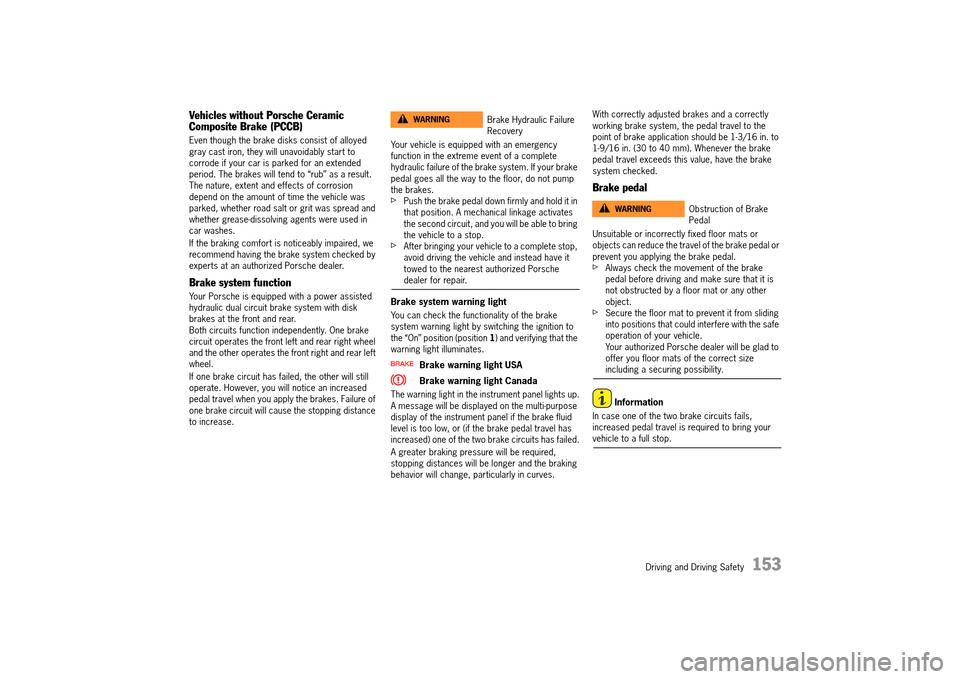
Driving and Driving Safety 153
Vehicles without Porsche Ceramic Composite Brake (PCCB)
Even though the brake disks consist of alloyed gray cast iron, they will unavoidably start to corrode if your car is parked for an extended period. The brakes will tend to “rub” as a result.The nature, extent and effects of corrosion depend on the amount of time the vehicle was parked, whether road salt or grit was spread and whether grease-dissolving agents were used in car washes.
If the braking comfort is noticeably impaired, we recommend having the brake system checked by experts at an authorized Porsche dealer.
Brake system function
Your Porsche is equipped with a power assisted hydraulic dual circuit brake system with disk brakes at the front and rear. Both circuits function independently. One brake circuit operates the front left and rear right wheel and the other operates the front right and rear left wheel.
If one brake circuit has failed, the other will still operate. However, you will notice an increased pedal travel when you apply the brakes. Failure of one brake circuit will cause the stopping distance to increase.
Your vehicle is equipped with an emergency function in the extreme event of a complete hydraulic failure of the brake system. If your brake pedal goes all the way to the floor, do not pump the brakes. fPush the brake pedal down firmly and hold it in that position. A mechanical linkage activates the second circuit, and you will be able to bring the vehicle to a stop.fAfter bringing your vehicle to a complete stop, avoid driving the vehicle and instead have it towed to the nearest authorized Porsche dealer for repair.
Brake system warning light
You can check the functionality of the brake system warning light by switching the ignition to the “On” position (position 1) and verifying that the warning light illuminates.
Brake warning light USA
Brake warning light Canada
The warning light in the instrument panel lights up. A message will be displayed on the multi-purpose display of the instrument panel if the brake fluid level is too low, or (if the brake pedal travel has increased) one of the two brake circuits has failed.
A greater braking pressure will be required, stopping distances will be longer and the braking behavior will change, particularly in curves.
With correctly adjusted brakes and a correctly working brake system, the pedal travel to the point of brake application should be 1-3/16 in. to 1-9/16 in. (30 to 40 mm). Whenever the brake pedal travel exceeds this value, have the brake system checked.
Brake pedal
Unsuitable or incorrectly fixed floor mats or objects can reduce the travel of the brake pedal or prevent you applying the brake pedal.fAlways check the movement of the brake pedal before driving and make sure that it is not obstructed by a floor mat or any other object.fSecure the floor mat to prevent it from sliding into positions that could interfere with the safe operation of your vehicle.Your authorized Porsche dealer will be glad to offer you floor mats of the correct size including a securing possibility.
Information
In case one of the two brake circuits fails, increased pedal travel is required to bring your vehicle to a full stop.
Brake Hydraulic Failure Recovery
WARNINGh
Obstruction of Brake Pedal
WARNINGh
14_991_Turbo_21.book Seite 153 Mittwoch, 9. April 2014 2:19 14
Page 157 of 300
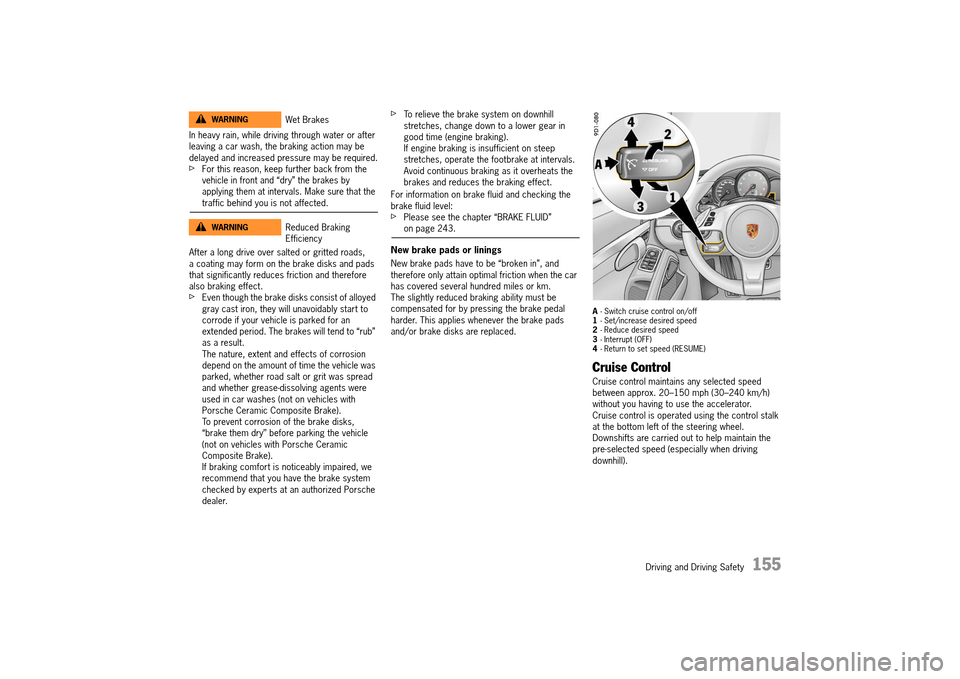
Driving and Driving Safety 155
In heavy rain, while driving through water or after leaving a car wash, the braking action may be delayed and increased pressure may be required.fFor this reason, keep further back from the vehicle in front and “dry” the brakes by applying them at intervals. Make sure that the traffic behind you is not affected.
After a long drive over salted or gritted roads, a coating may form on the brake disks and pads that significantly reduces friction and therefore also braking effect.fEven though the brake disks consist of alloyed gray cast iron, they will unavoidably start to corrode if your vehicle is parked for an extended period. The brakes will tend to “rub” as a result.The nature, extent and effects of corrosion depend on the amount of time the vehicle was parked, whether road salt or grit was spread and whether grease-dissolving agents were used in car washes (not on vehicles with Porsche Ceramic Composite Brake).To prevent corrosion of the brake disks, “brake them dry” before parking the vehicle (not on vehicles with Porsche Ceramic Composite Brake).If braking comfort is noticeably impaired, we recommend that you have the brake system checked by experts at an authorized Porsche dealer.
fTo relieve the brake system on downhill stretches, change down to a lower gear in good time (engine braking).If engine braking is insufficient on steep stretches, operate the footbrake at intervals. Avoid continuous braking as it overheats the brakes and reduces the braking effect.
For information on brake fluid and checking the brake fluid level:fPlease see the chapter “BRAKE FLUID” on page 243.
New brake pads or linings
New brake pads have to be “broken in”, and therefore only attain optimal friction when the car has covered several hundred miles or km.The slightly reduced braking ability must be compensated for by pressing the brake pedal harder. This applies whenever the brake pads and/or brake disks are replaced.
A - Switch cruise control on/off 1 - Set/increase desired speed 2 - Reduce desired speed 3 - Interrupt (OFF) 4 - Return to set speed (RESUME)
Cruise Control
Cruise control maintains any selected speed between approx. 20–150 mph (30–240 km/h) without you having to use the accelerator.Cruise control is operated using the control stalk at the bottom left of the steering wheel.Downshifts are carried out to help maintain the pre-selected speed (especially when driving downhill).
Wet Brakes
Reduced Braking Efficiency
WARNINGh
WARNINGh
14_991_Turbo_21.book Seite 155 Mittwoch, 9. April 2014 2:19 14
Page 166 of 300
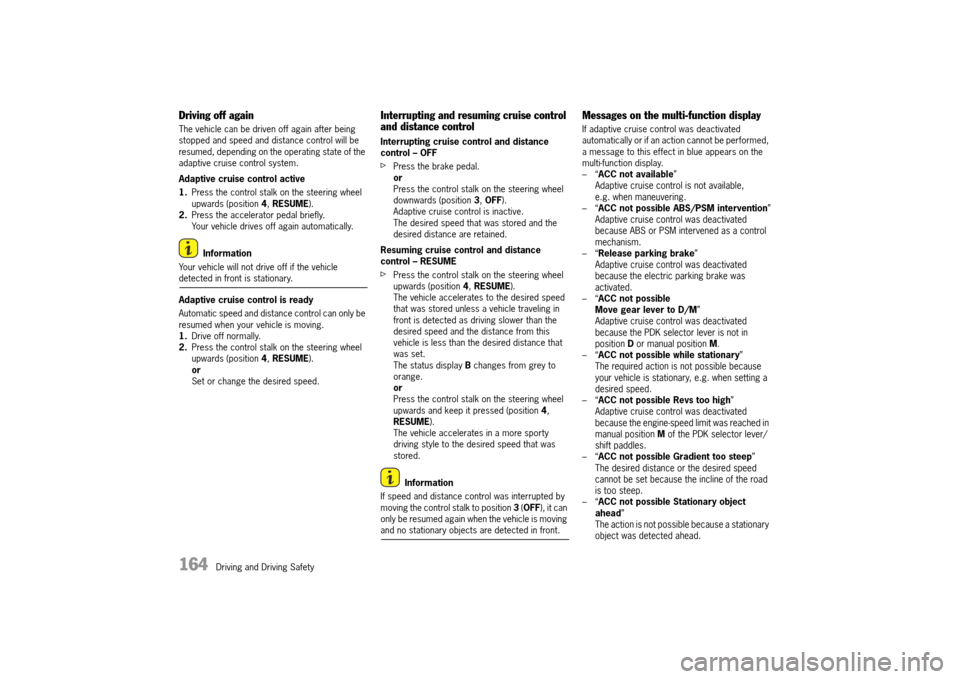
164 Driving and Driving Safety
Driving off again
The vehicle can be driven off again after being stopped and speed and distance control will be resumed, depending on the operating state of the adaptive cruise control system.
Adaptive cruise control active
1. Press the control stalk on the steering wheel upwards (position 4, RESUME). 2. Press the accelerator pedal briefly. Your vehicle drives off again automatically.
Information
Your vehicle will not drive off if the vehicle detected in front is stationary.
Adaptive cruise control is ready
Automatic speed and distance control can only be resumed when your vehicle is moving.1. Drive off normally. 2. Press the control stalk on the steering wheel upwards (position 4, RESUME). orSet or change the desired speed.
Interrupting and resuming cruise control and distance control
Interrupting cruise control and distance control – OFF
fPress the brake pedal.orPress the control stalk on the steering wheel downwards (position 3, OFF). Adaptive cruise control is inactive.The desired speed that was stored and the desired distance are retained.
Resuming cruise control and distance control – RESUME
fPress the control stalk on the steering wheel upwards (position 4, RESUME). The vehicle accelerates to the desired speed that was stored unless a vehicle traveling in front is detected as driving slower than the desired speed and the distance from this vehicle is less than the desired distance that was set.The status display B changes from grey to orange.orPress the control stalk on the steering wheel upwards and keep it pressed (position 4, RESUME ). The vehicle accelerates in a more sporty driving style to the desired speed that was stored.
Information
If speed and distance control was interrupted by moving the control stalk to position 3 (OFF), it can only be resumed again when the vehicle is moving and no stationary objects are detected in front.
Messages on the multi-function display
If adaptive cruise control was deactivated automatically or if an action cannot be performed, a message to this effect in blue appears on the multi-function display.–“ ACC not available” Adaptive cruise control is not available, e.g. when maneuvering.–“ ACC not possible ABS/PSM intervention” Adaptive cruise control was deactivated because ABS or PSM intervened as a control mechanism.–“ Release parking brake” Adaptive cruise control was deactivated because the electric parking brake was activated.–“ ACC not possible Move gear lever to D/M ” Adaptive cruise control was deactivated because the PDK selector lever is not in position D or manual position M. –“ ACC not possible while stationary” The required action is not possible because your vehicle is stationary, e.g. when setting a desired speed.–“ ACC not possible Revs too high” Adaptive cruise control was deactivated because the engine-speed limit was reached in manual position M of the PDK selector lever/ shift paddles.–“ ACC not possible Gradient too steep” The desired distance or the desired speed cannot be set because the incline of the road is too steep.–“ ACC not possible Stationary object ahead ” The action is not possible because a stationary object was detected ahead.
14_991_Turbo_21.book Seite 164 Mittwoch, 9. April 2014 2:19 14
Page 172 of 300
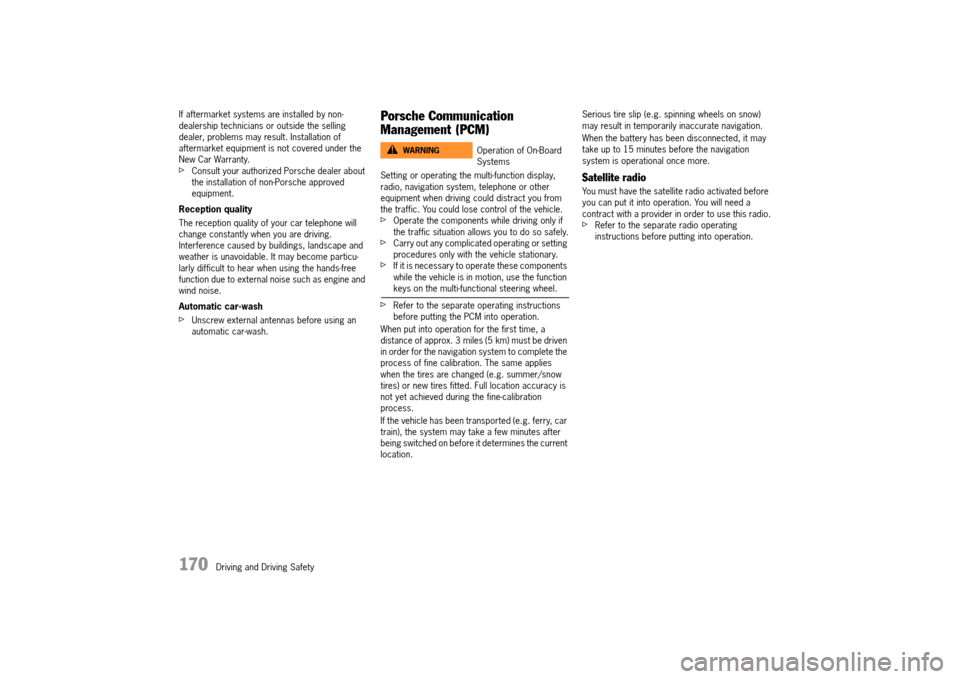
170 Driving and Driving Safety
If aftermarket systems are installed by non- dealership technicians or outside the selling dealer, problems may result. Installation of aftermarket equipment is not covered under the New Car Warranty. fConsult your authorized Porsche dealer about the installation of non-Porsche approved equipment.
Reception quality
The reception quality of your car telephone will change constantly when you are driving. Interference caused by buildings, landscape and weather is unavoidable. It may become particu-larly difficult to hear when using the hands-free function due to external noise such as engine and wind noise.
Automatic car-wash
fUnscrew external antennas before using an automatic car-wash.
Porsche Communication
Management (PCM)
Setting or operating the multi-function display, radio, navigation system, telephone or other equipment when driving could distract you from the traffic. You could lose control of the vehicle.fOperate the components while driving only if the traffic situation allows you to do so safely.fCarry out any complicated operating or setting procedures only with the vehicle stationary.fIf it is necessary to operate these components while the vehicle is in motion, use the function keys on the multi-functional steering wheel.
fRefer to the separate operating instructions before putting the PCM into operation.
When put into operation for the first time, a distance of approx. 3 miles (5 km) must be driven in order for the navigation system to complete the process of fine calibration. The same applies when the tires are changed (e.g. summer/snow tires) or new tires fitted. Full location accuracy is not yet achieved during the fine-calibration process.
If the vehicle has been transported (e.g. ferry, car train), the system may take a few minutes after being switched on before it determines the current location.
Serious tire slip (e.g. spinning wheels on snow) may result in temporarily inaccurate navigation.
When the battery has been disconnected, it may take up to 15 minutes before the navigation system is operational once more.
Satellite radio
You must have the satellite radio activated before you can put it into operation. You will need a contract with a provider in order to use this radio.fRefer to the separate radio operating instructions before putting into operation.
Operation of On-Board Systems
WARNINGh
14_991_Turbo_21.book Seite 170 Mittwoch, 9. April 2014 2:19 14
Page 174 of 300
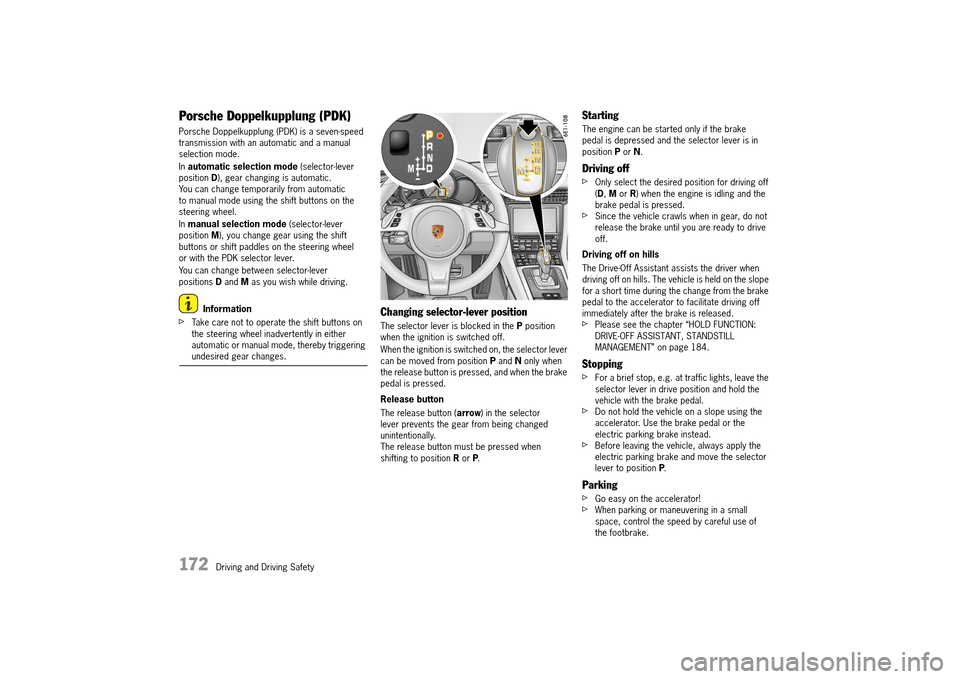
172 Driving and Driving Safety
Porsche Doppelkupplung (PDK)
Porsche Doppelkupplung (PDK) is a seven-speed transmission with an automatic and a manual selection mode.
In automatic selection mode (selector-lever position D), gear changing is automatic. You can change temporarily from automatic to manual mode using the shift buttons on the steering wheel.
In manual selection mode (selector-lever position M), you change gear using the shift buttons or shift paddles on the steering wheel or with the PDK selector lever.
You can change between selector-lever positions D and M as you wish while driving.
Information
fTake care not to operate the shift buttons on the steering wheel inadvertently in either automatic or manual mode, thereby triggering undesired gear changes.
Changing selector-lever position
The selector lever is blocked in the P position when the ignition is switched off.
When the ignition is switched on, the selector lever can be moved from position P and N only when the release button is pressed, and when the brake pedal is pressed.
Release button
The release button ( arrow) in the selector lever prevents the gear from being changed unintentionally.The release button must be pressed when shifting to position R or P.
Starting
The engine can be started only if the brake pedal is depressed and the selector lever is in position P or N.
Driving off
fOnly select the desired position for driving off ( D, M or R) when the engine is idling and the brake pedal is pressed.fSince the vehicle crawls when in gear, do not release the brake until you are ready to drive off.
Driving off on hills
The Drive-Off Assistant assists the driver when driving off on hills. The vehicle is held on the slope for a short time during the change from the brake pedal to the accelerator to facilitate driving off immediately after the brake is released.fPlease see the chapter “HOLD FUNCTION: DRIVE-OFF ASSISTANT, STANDSTILL MANAGEMENT” on page 184.
Stopping
fFor a brief stop, e.g. at traffic lights, leave the selector lever in drive position and hold the vehicle with the brake pedal.fDo not hold the vehicle on a slope using the accelerator. Use the brake pedal or the electric parking brake instead.fBefore leaving the vehicle, always apply the electric parking brake and move the selector lever to position P.
Parking
fGo easy on the accelerator!fWhen parking or maneuvering in a small space, control the speed by careful use of the footbrake.
14_991_Turbo_21.book Seite 172 Mittwoch, 9. April 2014 2:19 14
Page 176 of 300
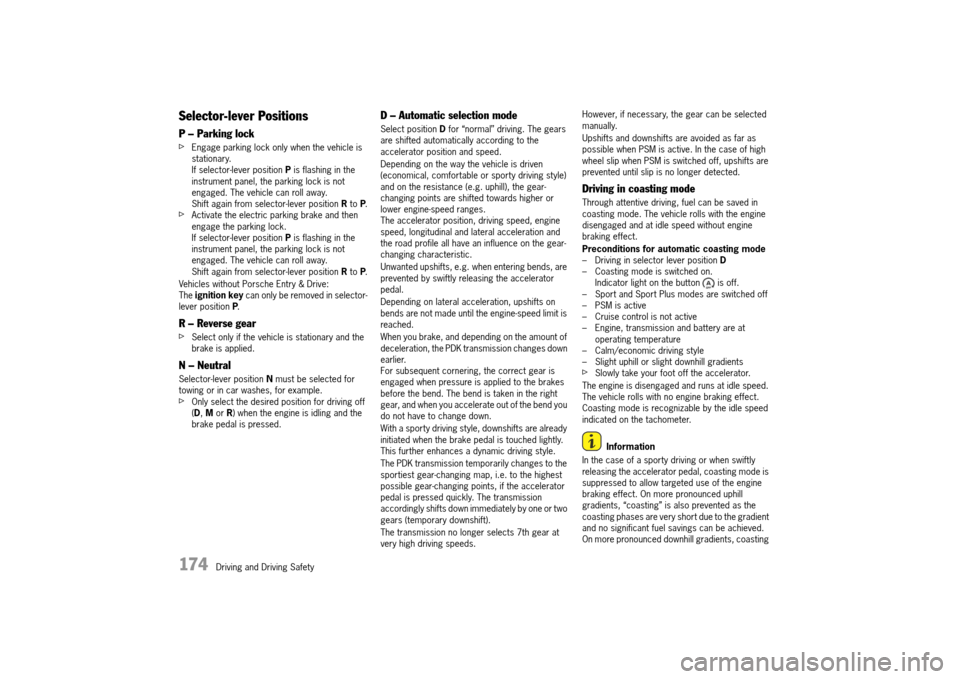
174 Driving and Driving Safety
Selector-lever Positions
P – Parking lock
fEngage parking lock only when the vehicle is stationary.If selector-lever position P is flashing in the instrument panel, the parking lock is not engaged. The vehicle can roll away.Shift again from selector-lever position R to P.fActivate the electric parking brake and then engage the parking lock.If selector-lever position P is flashing in the instrument panel, the parking lock is not engaged. The vehicle can roll away.Shift again from selector-lever position R to P.
Vehicles without Porsche Entry & Drive: The ignition key can only be removed in selector- lever position P.
R – Reverse gear
fSelect only if the vehicle is stationary and the brake is applied.
N – Neutral
Selector-lever position N must be selected for towing or in car washes, for example.fOnly select the desired position for driving off ( D, M or R) when the engine is idling and the brake pedal is pressed.
D – Automatic selection mode
Select position D for “normal” driving. The gears are shifted automatically according to the accelerator position and speed.
Depending on the way the vehicle is driven (economical, comfortable or sporty driving style) and on the resistance (e.g. uphill), the gear-changing points are shifted towards higher or lower engine-speed ranges.The accelerator position, driving speed, engine speed, longitudinal and lateral acceleration and the road profile all have an influence on the gear-changing characteristic.
Unwanted upshifts, e.g. when entering bends, are prevented by swiftly releasing the accelerator pedal.
Depending on lateral acceleration, upshifts on bends are not made until the engine-speed limit is reached.
When you brake, and depending on the amount of deceleration, the PDK transmission changes down earlier.For subsequent cornering, the correct gear is engaged when pressure is applied to the brakes before the bend. The bend is taken in the right gear, and when you accelerate out of the bend you do not have to change down.
With a sporty driving style, downshifts are already initiated when the brake pedal is touched lightly. This further enhances a dynamic driving style.
The PDK transmission temporarily changes to the sportiest gear-changing map, i.e. to the highest possible gear-changing points, if the accelerator pedal is pressed quickly. The transmission accordingly shifts down immediately by one or two gears (temporary downshift).
The transmission no longer selects 7th gear at very high driving speeds.
However, if necessary, the gear can be selected manually.
Upshifts and downshifts are avoided as far as possible when PSM is active. In the case of high wheel slip when PSM is switched off, upshifts are prevented until slip is no longer detected.
Driving in coasting mode
Through attentive driving, fuel can be saved in coasting mode. The vehicle rolls with the engine disengaged and at idle speed without engine braking effect.
Preconditions for automatic coasting mode – Driving in selector lever position D – Coasting mode is switched on.Indicator light on the button is off.– Sport and Sport Plus modes are switched off– PSM is active– Cruise control is not active– Engine, transmission and battery are at operating temperature– Calm/economic driving style– Slight uphill or slight downhill gradientsfSlowly take your foot off the accelerator.
The engine is disengaged and runs at idle speed. The vehicle rolls with no engine braking effect. Coasting mode is recognizable by the idle speed indicated on the tachometer.
Information
In the case of a sporty driving or when swiftly releasing the accelerator pedal, coasting mode is suppressed to allow targeted use of the engine braking effect. On more pronounced uphill gradients, “coasting” is also prevented as the coasting phases are very short due to the gradient and no significant fuel savings can be achieved. On more pronounced downhill gradients, coasting
14_991_Turbo_21.book Seite 174 Mittwoch, 9. April 2014 2:19 14